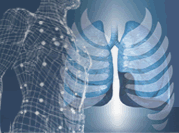 |

OEP System has been used in a wide range of applications by researchers and
doctors all around the world.
Their results have been documented and published by many scientific journals and publications.
What follows is a selected list that describes what was made possible by
BTS's OEP System.
Chronic Obstructive Pulmonary Disease (COPD) patients
OEP System can be used to dynamically track absolute lung volumes during exercise
in COPD patients and to assess possible dynamic hyperinflation without requiring
manoeuvers like inspiratory capacity. Also, OEP System can be used to study the effect
of pharmacological treatment like bronchodilators in the subdivision of lung and chest
wall volumes.
References:
Aliverti A, Stevenson
N, Dellacą RL, Lo Mauro A, Pedotti A, Calverley PMA. Regional
Chest Wall Volumes during exercise in Chronic Obstructive Pulmonary
Disease. Thorax, in press.
Aliverti A, Dellacą
R, Stevenson N, Pedotti A, Lo Mauro A, Calverley PMA. Effects
of bronchodilators on subdivisions of lung and chest wall volume
in COPD. Eur. Respir. J., 20, suppl.
38,13s, 2002
 Top Top
Asthma and bronchoconstriction
The effects of bronchocostriction in asthmatic patients on hyperinflation,
chest wall mechanics, and rib cage distortion have been recently studied by OEP System.
References:
Gorini M, Iandelli I, Misuri G,
Bertoli F, Filippelli M, Mancini M, Duranti R, Gigliotti F, Scano
G. Chest wall hyperinflation during
acute bronchoconstriction in asthma. Am.
J. Resp. Critic. Care Med., 160:808-816, 1999
 Top Top
Hemiplegic patients
The unique ability of OEP System to measure symmetry in right/left respiratory
movements has been recently used to investigate differences between paretic and
healthy sides in patients with hemiparesis
References:
Lanini B, Bianchi R, Romagnoli I, Coli C, Binazzi B, Gigliotti F, Pizzi A, Grippo A, Scano G.
Chest wall kinematics in patients with hemiplegia.
Am. J. Respir Critic. Care Med., 168(1):109-13, 2003
 Top Top
Intensive Care Unit (ICU) Patients
In the assessment of intensive care patients submitted to mechanical ventilation,
OEP System can substantially help to better investigate the
alterations of chest wall mechanics and the relationships between
lung and chest wall, particularly in critically ill patients with
acute respiratory distress syndrome (ARDS). Typical applications
include the complete monitoring of ventilatory parameters during
weaning from mechanical ventilation, and the assessment of its prognostic
value in predicting which patients can sustain spontaneous or non
invasive assisted methods of ventilation, and which may require
intubation.
References:
Aliverti A, Dellacą
RL, Pelosi R, Chiumello D, Pedotti A, Gattinoni L. Opto-electronic
plethysmography in intensive care patients. Am.
J. Resp. Crit. Care Med., 161: 1546-1552, 2000
Dellacą RL, Aliverti A, Pelosi P, Carlesso E, Chiumello D, Pedotti A, Gattinoni L.
Estimation of end-expiratory lung volume variations by optoelectronic plethysmography.
Crit. Care Med., 29(9):1807-11, 2001.
 Top Top
Spinal Cord Injury (SCI) Patients
OEP System was recently used to study tetraplegic patients. This was the first report that
showed the usefulness of this technique for the optimization of mechanical ventilation, phrenic
nerve stimulation and functional electrical stimulation of abdominal muscles in these patients.
References:
Kandare F, Exner G, Jeraj J, Aliverti
A, Dellacą RL, Stanic U, Pedotti A, Jaeger R. Breathing
induced by abdominal muscle stimulation in individuals without spontaneous
ventilation. Neuromodulation, 5(3):
180-185, 2002
 Top Top
Physiology
OEP System has been widely used to investigate the mechanisms of respiratory muscle action
and control, to quantify chest wall volumes, rib cage distortion and blood shifts during exercise
in healthy subjects both in normal conditions and during artificially-induced expiratory flow limitations.
References:
Aliverti A, Cala SJ, Duranti R, Ferrigno G, Kenyon CM, Pedotti A, Scano G, Sliwinski P, Macklem PT and Yan S.
Human Respiratory Muscle Actions and Control during Exercise.
J. Appl. Physiol. 83(4): 1256-1269, 1997
Kenyon CM, Cala SJ, Yan S, Aliverti A, Scano G, Duranti R, Pedotti A and Macklem PT.
Rib Cage Mechanics during Quiet Breathing and Exercise in Humans.
J. Appl. Physiol. 83(4): 1242-1255, 1997
Aliverti A, Iandelli I, Duranti R, Cala S, Kayser B, Kelly S, Misuri G, Pedotti A, Scano G, Sliwinski P, Yan S, Macklem PT.
Respiratory muscle dynamics and control during exercise with externally imposed expiratory flow-limitation.
J. Appl. Physiol., 92(5): 1953-1963, 2002
Iandelli I, Aliverti A, Kayser
B, Dellacą RL, Cala S, Duranti R, Kelly S, Scano G, Sliwinski P,
Yan S, Macklem PT, Pedotti A. Determinants
of exercise performance in normal men with externally imposed expiratory
flow-limitation. J. Appl. Physiol.,
92(5): 1943-1952, 2002
 Top Top
|
 |

